Rice Milling Machinery Market Size
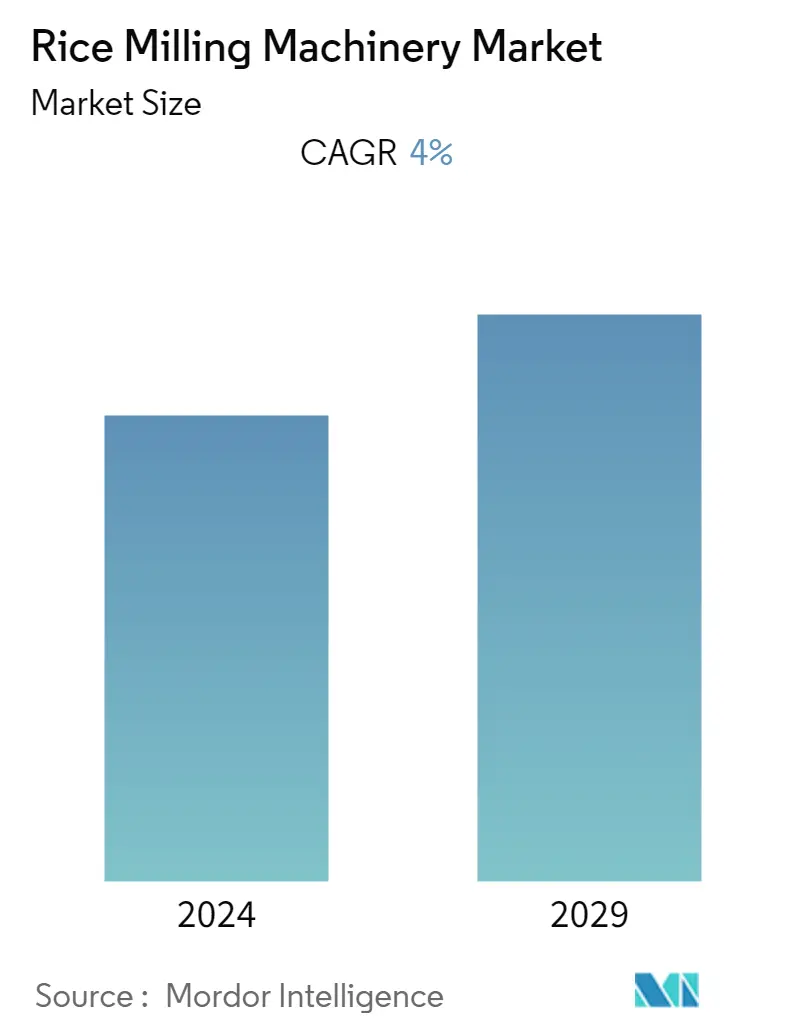
| Study Period | 2019 - 2029 |
| Base Year For Estimation | 2023 |
| CAGR | 4.00 % |
| Fastest Growing Market | Asia-Pacific |
| Largest Market | Asia Pacific |
| Market Concentration | Low |
Major Players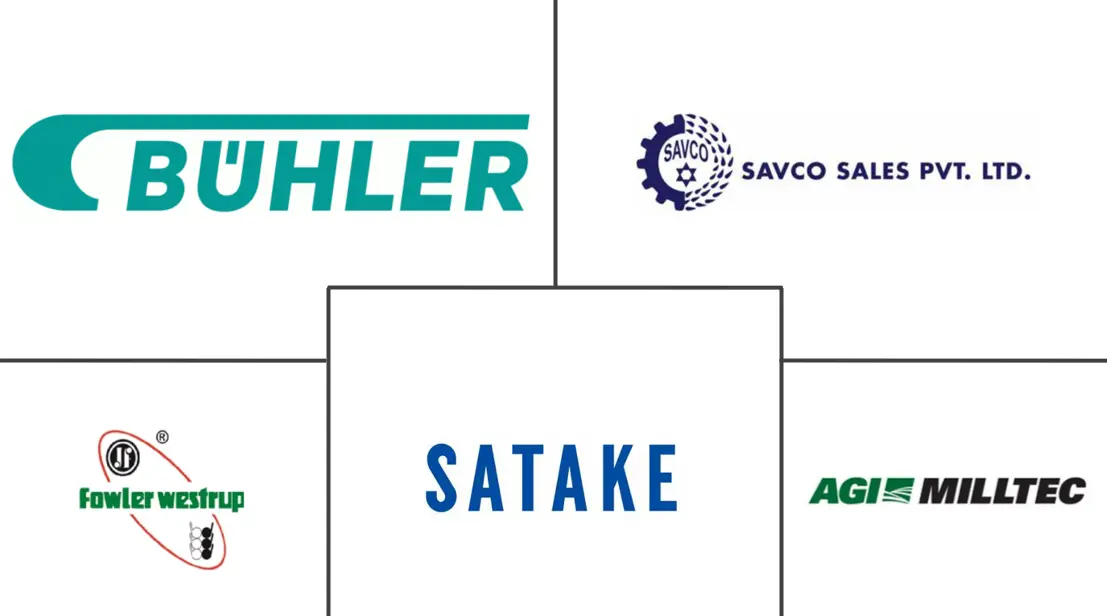
*Disclaimer: Major Players sorted in no particular order |
Rice Milling Machinery Market Analysis
The Rice Milling Machinery Market size is estimated at USD 230.14 million in 2023, and is expected to reach USD 280 million by 2028, growing at a CAGR of 4% during the forecast period (2023-2028).
- Rice, the primary staple for more than half the world's population, is produced worldwide, with about 90 percent grown in Asia. While Indica, Aromatic(Jasmine and Basmati), Japonica, and Glutinous rice are four major categories of rice, many other specialty varieties of rice are also produced globally.
- The demand for certified rice milling machinery is driving the growth of the rice milling machinery market. This is because certified machinery ensures high-quality rice processing, which is necessary to meet the growing demand for rice. As rice is a staple food in many countries, the demand for rice is expected to remain high in the foreseeable future. This, in turn, will continue to drive the demand for rice milling machinery.
- However, the availability of pre-used models of rice milling machinery may impede the market growth. Regarding the latest development in rice milling technology, the Satake New Tasty White Process (NTWP) is a breakthrough in rice processing. The NTWP process produces rinse-free rice of enhanced quality in terms of taste and appearance. This technology has the potential to revolutionize the rice milling industry by offering higher-quality rice while reducing water usage and processing time. This could lead to increased efficiency, reduced costs, and ultimately, higher profits for rice millers.
- The stipulation for rice is expanding with the rising global population, which led to many rice processing plants opening new rice mills and boosting the market's growth. India is the largest producer and exporter of Basmati rice and one of the largest exporters of rice. Rice milling is perhaps the country's oldest and biggest agro-processing industry.
Rice Milling Machinery Market Trends
Rising Area Under Rice Cultivation
- Rice is the primary staple food for more than half the world's population, with Asia, Sub-Saharan Africa, and South America as the largest consuming regions. Asia is the largest producer of rice, including countries like China and India, which are among the largest producers and consumers of rice. According to the Food and Agriculture Organization (FAO), in 2021, the total area harvested by India accounted for 46.2 million metric tons, followed by China with 29.9 million metric tons, Bangladesh with 11.7 million metric tons, Thailand with 11.2 million metric tons, and Indonesia with 10.4 million metric tons. This increase in the area harvested shows the increase in the requirement for more milling machinery to extract rice from paddy for consumption.
- According to the United States Department of Agriculture (USDA) report 2021, four regions produced almost the entire United States rice crop production: Arkansas Grand Prairie, Mississippi Delta, Gulf Coast, and Sacramento Valley of California. Each region normally specializes in a specific type of rice, referred to in the United States by the long, medium, and short grain length.
- The United States long-grain rice is typically dry and separates when cooked, while medium- and short-grain rice are typically moist and clingy. In general, long-grain production accounts for around 75 percent of United States rice production, medium-grain production for about 24 percent, and short-grain for the remainder.
- Paddy rice cultivation is limited to areas with specific climatic conditions, such as high temperatures, high humidity, and abundant rainfall. As a result, it is grown primarily in regions of Asia, such as China, India, and Southeast Asia, as well as in regions of Africa and South America. However, the rising adoption of high-yielding varieties and new cultivation techniques, such as alternate wetting and drying (AWD), has allowed for increased rice cultivation in areas that were previously unsuitable.
- The rising demand for high-quality rice and the increasing adoption of new cultivation techniques and high-yielding varieties presents a significant opportunity for players in the rice milling machinery market. These players can offer advanced machines that can improve the efficiency of the rice milling process, reduce labor costs, and increase the quality of the final product.
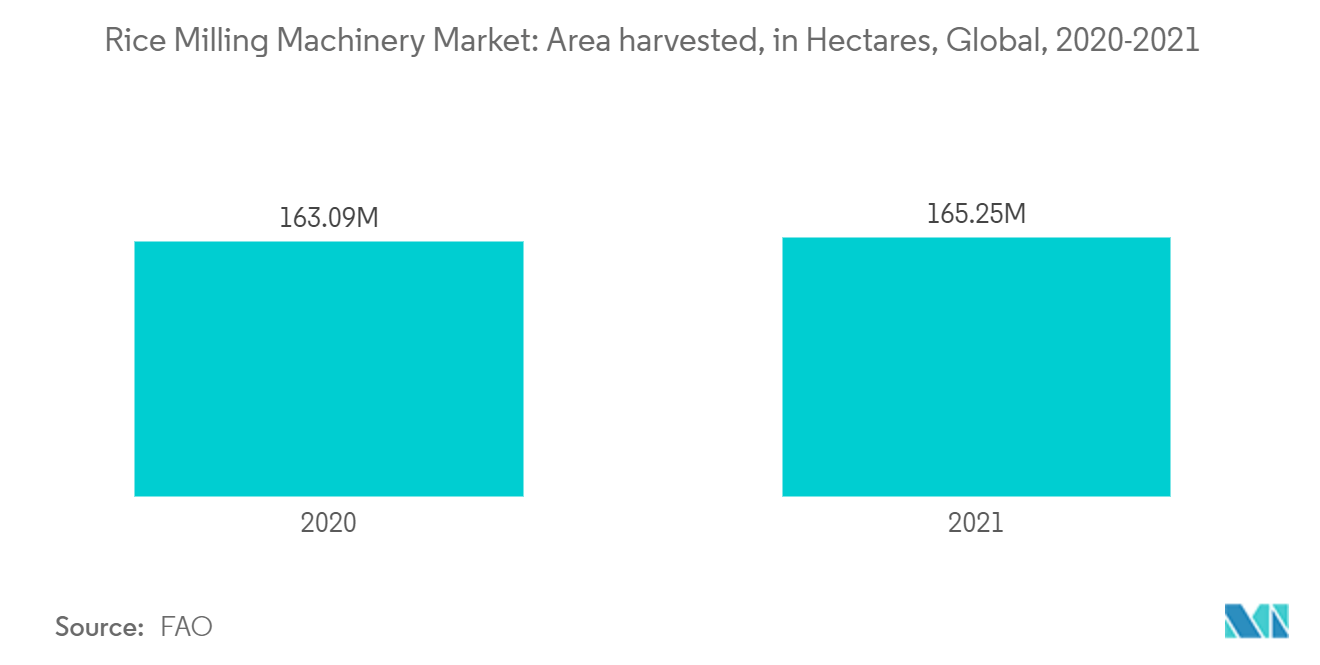
Asia-Pacific Dominates the Market
- Rice, wheat, and corn are the major consumed staple crops worldwide, whereas rice is a major staple crop among the three, helping more than half of the global population meet its daily calorie requirements. More than 90 percent of the world's rice is grown in Asia, principally in China, India, Indonesia, and Bangladesh, with smaller amounts grown in Japan, Pakistan, and various Southeast Asian nations.
- According to the Food and Agriculture Organization (FAO), in the year 2021, the total area harvested by India accounted for 46.2 million metric tons, followed by China with 29.9 million metric tons, Bangladesh with 11.7 million metric tons, Thailand with 11.2 million metric tons and Indonesia with 10.4 million metric tons.
- Integrated Crop Management (ICM) approaches for rice crops involve location-specific technologies combined with effective institutional support from governments, research institutions, and extension services. This approach aims to optimize the use of available resources, minimize the impact of pests and diseases, and improve the overall productivity and sustainability of rice farming. Using ICM approaches, farmers can bridge the yield gap and increase their rice production. Governments can support farmers by providing access to input and village credit supplies, as well as strengthening research and extension linkages to disseminate new knowledge and technologies.
- According to FAO, rice consumption in Asia by 2025 will increase by more than 51 percent. This increase in demand for rice due to the population increase in the region will drive the rice milling market during the forecast year.
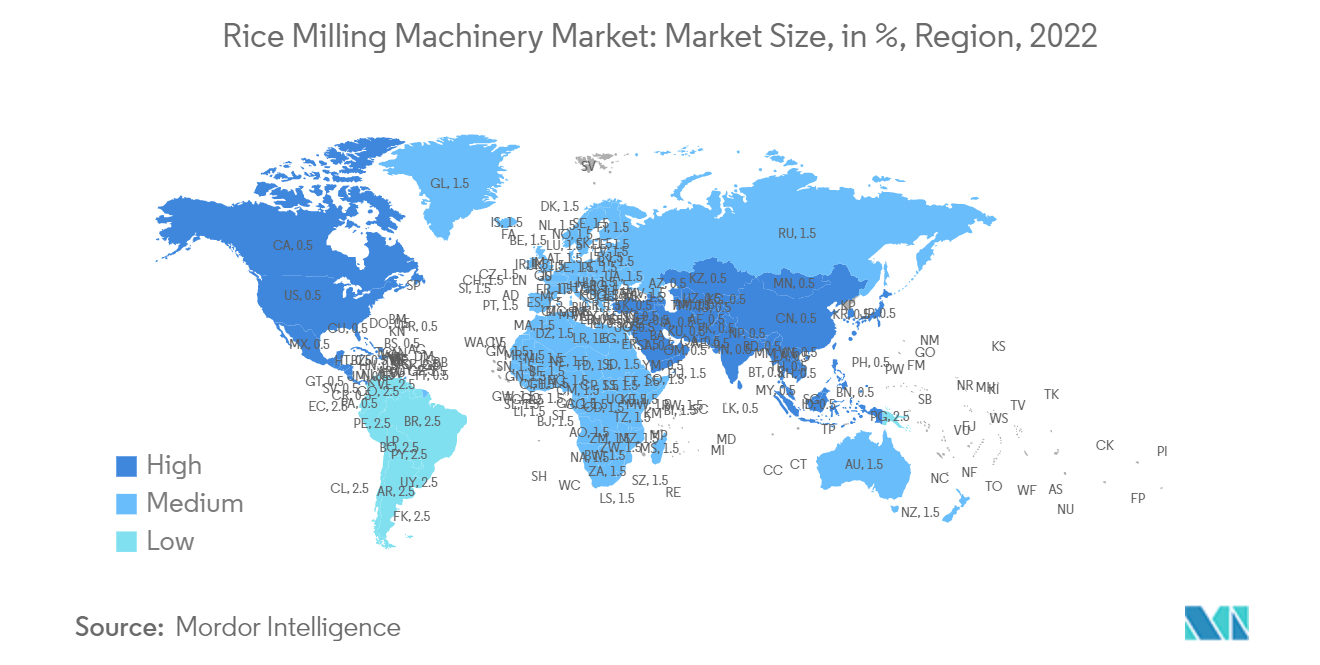
Rice Milling Machinery Industry Overview
The rice milling machinery market is fragmented with a few big players, resulting in competition between small players. Buhler Group, Fowler Westrup, MillTECH Machinery Private Ltd, Savco Sales Pvt. Ltd and Satake Group are some of the prominent players with their distribution and manufacturing facilities worldwide. New product launches, partnerships, and acquisitions are the major strategies adopted by the leading companies in the market in the country.
Along with innovations and expansions, investments in R&D and developing novel product portfolios will likely be crucial strategies in the coming years. These companies are making strategic partnerships by partnering with domestic companies to expand their distribution network and launch new innovative milling machinery that caters to the needs of the farmers in the respective regions.
Rice Milling Machinery Market Leaders
-
Buhler Group
-
Fowler Westrup
-
MillTECH Machinery Private Ltd
-
Satake Group
-
Savco Sales Pvt. Ltd
*Disclaimer: Major Players sorted in no particular order
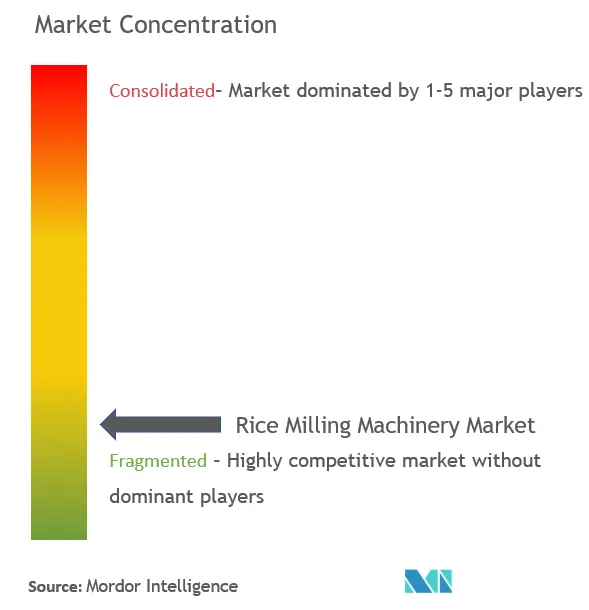
Rice Milling Machinery Market News
- January 2022: Benlink, a company owned by Buhler, announced its strategic partnership with Alfa Level to expand heat transfer, centrifugal separation, and fluid handling in rice milling.
- June 2021: Hubei Bishan Machinery Co. Ltd launched its new MNMSL 46 RICE whitener, which is expected to boost market growth.
Rice Milling Machinery Market Report - Table of Contents
1. INTRODUCTION
- 1.1 Study Assumptions and Market Definition
- 1.2 Scope of the Study
2. RESEARCH METHODOLOGY
3. EXECUTIVE SUMMARY
4. MARKET DYNAMICS
- 4.1 Market Overview
- 4.2 Market Drivers
- 4.3 Market Restraints
-
4.4 Porter's Five Forces Analysis
- 4.4.1 Threat of New Entrants
- 4.4.2 Bargaining Power of Buyers
- 4.4.3 Bargaining Power of Suppliers
- 4.4.4 Threat of Substitute Products
- 4.4.5 Intensity of Competitive Rivalry
5. MARKET SEGMENTATION
-
5.1 Mechanism
- 5.1.1 Fraction Rice Milling Machine
- 5.1.2 Grind Rice Milling Machine
-
5.2 Operations
- 5.2.1 Pre-cleaning Machinery
- 5.2.2 Separating Machinery
- 5.2.3 Grading Machinery
- 5.2.4 Rice Whitening Machinery
- 5.2.5 Other Operations
-
5.3 Geography
- 5.3.1 North America
- 5.3.1.1 United States
- 5.3.1.2 Canada
- 5.3.1.3 Mexico
- 5.3.1.4 Rest of North America
- 5.3.2 Europe
- 5.3.2.1 Germany
- 5.3.2.2 United Kingdom
- 5.3.2.3 France
- 5.3.2.4 Italy
- 5.3.2.5 Spain
- 5.3.2.6 Rest of Europe
- 5.3.3 Asia-Pacific
- 5.3.3.1 India
- 5.3.3.2 China
- 5.3.3.3 Japan
- 5.3.3.4 Rest of Asia-Pacific
- 5.3.4 South America
- 5.3.4.1 Brazil
- 5.3.4.2 Argentina
- 5.3.4.3 Rest of South America
- 5.3.5 Africa
- 5.3.5.1 South Africa
- 5.3.5.2 Rest of Africa
6. COMPETITIVE LANDSCAPE
- 6.1 Most Adopted Strategies
- 6.2 Market Share Analysis
-
6.3 Company Profiles
- 6.3.1 Buhler AG
- 6.3.2 Fowler Westrup
- 6.3.3 AG Growth International Inc.
- 6.3.4 MillTECH Machinery Private Ltd
- 6.3.5 Yamanoto
- 6.3.6 Zhejiang QiLi Machinery Co. Ltd
- 6.3.7 Satake Corporation
- 6.3.8 Mill Master Machinery Pvt. Ltd
- 6.3.9 G S International
- 6.3.10 G.G. Dandekar Machine Work
- 6.3.11 Hubei Bishan Machinery Co. Ltd
- *List Not Exhaustive
7. MARKET OPPORTUNITIES AND FUTURE TRENDS
** Subject To AvailablityRice Milling Machinery Industry Segmentation
Rice milling is a crucial step in the post-production of rice. The basic objective of a rice milling system is to clean impurities and remove the husk and the bran layers to produce white rice, which is edible and good for consumption.
The rice milling machinery market is segmented by mechanism (fraction rice milling machine and grind rice milling machine), operations (pre-cleaning machinery, separating machinery, grading machinery, rice whitening machinery, and other operations), and geography (North America, Europe, Asia-Pacific, South America, and Africa).
The market sizing has been done in value terms in USD for all the abovementioned segments.
| Mechanism | Fraction Rice Milling Machine | |
| Grind Rice Milling Machine | ||
| Operations | Pre-cleaning Machinery | |
| Separating Machinery | ||
| Grading Machinery | ||
| Rice Whitening Machinery | ||
| Other Operations | ||
| Geography | North America | United States |
| Canada | ||
| Mexico | ||
| Rest of North America | ||
| Geography | Europe | Germany |
| United Kingdom | ||
| France | ||
| Italy | ||
| Spain | ||
| Rest of Europe | ||
| Geography | Asia-Pacific | India |
| China | ||
| Japan | ||
| Rest of Asia-Pacific | ||
| Geography | South America | Brazil |
| Argentina | ||
| Rest of South America | ||
| Geography | Africa | South Africa |
| Rest of Africa |
Rice Milling Machinery Market Research FAQs
What is the current Rice Milling Machinery Market size?
The Rice Milling Machinery Market is projected to register a CAGR of 4% during the forecast period (2024-2029)
Who are the key players in Rice Milling Machinery Market?
Buhler Group, Fowler Westrup, MillTECH Machinery Private Ltd, Satake Group and Savco Sales Pvt. Ltd are the major companies operating in the Rice Milling Machinery Market.
Which is the fastest growing region in Rice Milling Machinery Market?
Asia-Pacific is estimated to grow at the highest CAGR over the forecast period (2024-2029).
Which region has the biggest share in Rice Milling Machinery Market?
In 2024, the Asia Pacific accounts for the largest market share in Rice Milling Machinery Market.
What years does this Rice Milling Machinery Market cover?
The report covers the Rice Milling Machinery Market historical market size for years: 2019, 2020, 2021, 2022 and 2023. The report also forecasts the Rice Milling Machinery Market size for years: 2024, 2025, 2026, 2027, 2028 and 2029.
Rice Milling Machinery Industry Report
Statistics for the 2024 Rice Milling Machinery market share, size and revenue growth rate, created by Mordor Intelligence™ Industry Reports. Rice Milling Machinery analysis includes a market forecast outlook to 2029 and historical overview. Get a sample of this industry analysis as a free report PDF download.



